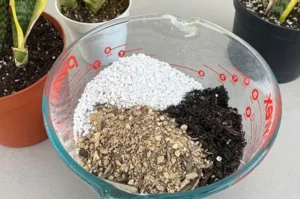Snake plants (Sansevieria), also known as mother-in-law’s tongue, are popular houseplants due to their hardy nature and low-maintenance care. But as the seasons change, especially during winter, many plant owners notice slower growth and sometimes even worry that their snake plant might be dying.
The truth is, snake plants go dormant in winter, which is a natural response to the colder temperatures and reduced light. In this article, we’ll explore what dormancy means for your snake plant, how to care for it during the colder months, and signs to watch out for to ensure it remains healthy.
What Does Dormancy Mean in Plants?
Dormancy is a survival mechanism in many plants, including snake plants. During this time, the plant slows down or completely stops growing. This is a way to conserve energy when conditions like sunlight, temperature, and humidity are not ideal.
For snake plants, dormancy typically occurs in late fall through winter, especially in colder regions or places with reduced daylight.
Do Snake Plants Go Dormant in Winter
Yes, they do. Unlike tropical plants that need consistent warmth, snake plants adapt to their environment by going into dormancy during winter. During this period:
- Growth slows down or halts completely.
- The soil stays moist for longer as the plant drinks less.
- Leaves may appear dull or stop producing new shoots.
This is completely normal and not a cause for concern.
Why Do Snake Plants Go Dormant in Winter?
Here are the main reasons:
- Reduced Sunlight: Shorter days and less intense sunlight mean less energy for photosynthesis.
- Cooler Temperatures: Snake plants prefer warmth, and colder air causes them to conserve energy.
- Lower Humidity: Winter air tends to be dry, especially indoors with heating systems on, which can stress the plant.
- Natural Cycle: Just like animals hibernate, some plants take a rest period too.
How to Care for a Dormant Snake Plant in Winter
While your plant is dormant, it doesn’t mean you should neglect it. You just need to adjust your care routine.
1. Reduce Watering
Overwatering in winter is the most common reason snake plants rot. Water only when the soil is completely dry, this could be once every 3–4 weeks. Always check the soil first.
2. Avoid Fertilizing
During dormancy, the plant isn’t growing, so it doesn’t need fertilizer. Resume feeding in spring when you see new growth.
3. Provide Indirect Light
Place your snake plant near a window where it gets bright, indirect sunlight. Avoid harsh direct sun and total shade.
4. Keep Away from Drafts
Cold air from windows or doors can shock your plant. Move it away from direct drafts and maintain a temperature above 50°F (10°C).
5. Don’t Repot
Winter is not the time to repot a snake plant. Wait until spring or summer when the plant is actively growing again.
Common Signs of Dormancy vs. Problems
Sometimes, it’s hard to tell if your plant is dormant or unhealthy. Here’s how you can differentiate:
| Dormancy Sign | Problem Sign |
|---|---|
| No new growth | Mushy, brown roots (root rot) |
| Leaves firm but dull | Yellowing or wilting leaves |
| Soil stays dry longer | Foul smell from soil |
| The plant looks unchanged | Leaves falling off or soggy |
If your plant looks healthy but just isn’t growing, it’s likely dormant. But if you notice signs of root rot, pests, or leaf damage, it may be a problem that needs attention.
How Long Does Dormancy Last?
Dormancy usually lasts from late fall to early spring, depending on your region. As the days get longer and warmer, you’ll see your snake plant perk up and begin growing again.
Patience is key. Don’t try to force growth with fertilizer or excessive watering — this can do more harm than good.
Tips to Keep Your Snake Plant Healthy During Dormancy
- Rotate the plant occasionally so all sides get light.
- Dust the leaves gently to allow better photosynthesis.
- Avoid placing it near heaters or cold windows.
- If you use grow lights, keep them on for 10–12 hours daily to supplement sunlight.
Frequently Asked Questions (FAQs)
Should I move my snake plant during winter?
Yes, if it’s near a drafty window or heater, move it to a more stable environment with indirect sunlight and steady temperatures.
My snake plant is not growing in winter. Is it dead?
No, it’s likely dormant. As long as the leaves are firm and not discolored or mushy, your plant is healthy.
Can I propagate snake plant during dormancy?
It’s not recommended. Wait until spring when the plant is active and more likely to produce strong roots.
Is yellowing a sign of dormancy?
Not necessarily. Yellowing can be due to overwatering or poor light. Dormant leaves usually stay green but do not grow.
What temperature is too cold for snake plants?
Anything below 50°F (10°C) can be risky. Avoid exposing your plant to freezing temperatures.
Conclusion
Snake plants are incredibly resilient and adaptable. Yes, they do go dormant in winter, and this is a normal part of their life cycle. Understanding this dormancy helps you adjust your care and avoid common mistakes like overwatering or fertilizing at the wrong time.
By creating a stable, warm, and well-lit environment, your snake plant will make it through winter just fine, ready to thrive again in spring.
Let your snake plant rest during the colder months, and in return, it will reward you with healthy, vibrant growth when the seasons change.






